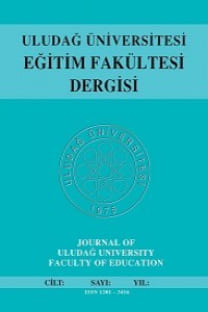Duyarlı Sevgi Ölçeği: Geçerlik ve Güvenirlik Çalışması
Bu araştırmanın amacı Duyarlı Sevgi Ölçeği’nin (DSÖ; Sprecher & Fehr, 2005) Türkçe formunun geçerlik ve güvenirliğini incelemektir. Araştırma 356 lise son sınıf öğrencisi üzerinde yürütülmüştür. Dilsel eşdeğerlik çalışmasında, DSÖ’nün Türkçe ve orijinal formlarında bulunan maddeler arasındaki korelasyon katsayıları 0,77 ile 0,97 arasında bulunmuştur. Açımlayıcı faktör analizinde 21 maddenin toplam varyansın %36,47’sini açıkladığı ve maddelerin tek boyutta toplandığı görülmüştür. Ölçeğin faktör yükleri 0,28 ile 0,78, madde toplam korelasyonu puanları ise 0,28 ile 0,70 arasında sıralanmaktadır. Doğrulayıcı faktör analizinde tek boyutlu modelin iyi uyum verdiği görülmüştür (x2=577,16, N=356, sd=181, p=0,0000, RMSEA= 0,079, NFI= 0,94, CFI= 0,96, RFI= 0,93, SRMR= 0,063). DSÖ’nün iç tutarlılık güvenirlik katsayısı 0,89, test-tekrar test güvenirlik katsayısı ise 0,82 olarak bulunmuştur. Bu sonuçlar DSÖ’nün Türkçe formunun geçerli ve güvenilir bir ölçme aracı olduğunu göstermektedir
Anahtar Kelimeler:
Duyarlı sevgi, Geçerlik, Güvenirlik.
Duyarlı Sevgi Ölçeği: Geçerlik ve Güvenirlik Çalışması
Keywords:
-,
___
- Batson, C. D. and Oleson, K. C. 1991. Current status of the empathy- altruism hypothesis. In M. S. Clark (Ed.), Review of personality and social psychology. Newbury Park, CA: Sage.
- Batson, C. D.,Chang, J., Orr, R. and Rowland, J. 2002. Empathy, attitudes, and action: Can feeling for a member of a stigmatized group motivate one to help the group? Personality and Social Psychology Bulletin, 28, 1656-1666.
- Berscheid, E. 2006. Searching for the meaning of ‘love’. In R. J. Sternberg & K. Weis (Eds.), The new psychology of love (s. 171-183). New Haven, CT: Yale University Press.
- Büyüköztürk, Ş. 2004. Veri analizi el kitabı. Ankara: Pegem A Yayıncılık.
- Davis, M. H. 1996. Empathy: A social psychological approach. Boulder, CO: Westview Press.
- Dovidio, J. F. and Penner, L. A. 2001. Helping and altruism. In M. Brewer & M. Hewstone (Eds.), Blackwell international handbook of social psychology: Interpersonal processes (s. 162-195). Cambridge, MA: Blackwell.
- Fehr, B. and Sprecher, S. 2009. Prototype analysis of the concept of compassionate love. Journal of Social and Personal Relationships, 16, 343-364.
- Fehr, B., Sprecher, S. and Underwood, L. 2009. Compassionate love: Theory, research, and applications. Malden, MA: Wiley-Blackwell.
- Hatfield, E. and Sprecher, S. 1983. Equity theory and recipient reactions to aid. In J.D. Fisher, A. Nadler, & B. DePaulo (Eds.), New directions in helping. Volume 1: Recipient reactions to aid (pp. 113-141). New York: Academic Press.
- Hendrick, S.S. and Hendrick, C. 2000. Romantic love. In C. Hendrick, & S.S Hendrick (Eds.), Close Relationships: A sourcebook (s. 203-215). Thousand Oaks+, CA: Sage.
- Joreskog, K. G. and Sorbom, D. 1996. LISREL 8 reference guide. Lincolnwood, IL: Scientific Software International.
- Hu, L. T. and Bentler, P. M. 1999. Cutoff criteria for fit indexes in covariance structural analysis: Conventional criteria versus new alternatives. Structural Equation Modeling, 6, 1-55.
- Lazarus, R. S. 1991. Emotion and adaption. New York: Oxford University Press.
- Leak, G. K. 1991. Two social interest measures and social desirability response sets. J Indiv Psychol 1991; 47: 136-140.
- Marks, N. F. and Song, J. 2009. Compassionate motivation and compassionate acts across the adult life course: Evidence from US national studies. In B. Fehr, S. Sprecher, & L. G. Underwood (Eds.), The science of compassionate love: Theory, research and applications (s. 121-158). Malden, MA: Wiley-Blackwell.
- Mills, J. and Clark, M. S. 1994. Communal and exchange relationships: Controversies and research. In R. Erber & R. Gilmour (Eds.), Theoretical frameworks for personal relationships (s. 29-42). Hillsdale, NJ: Erlbaum.
- Nikelly, A. G. 2005. Positive health outcomes of social interest. J Indiv Psychol 2005; 61: 329-342.
- Post, S. G., Underwood, L. G., Schloss, J. P. and Hurlbut, W. B. (Eds.) 2002. Altruism and altruistic love. New York: Oxford University Press.
- Sedikides, C., Oliver, M. B. and Campbell, W. K. 1994. Perceived benefits and costs of romantic relationships for women and men: Implications for exchange theory. Personal Relationships, 1, 5-21.
- Smith, T. W. 2009. Loving and caring in the United States: Trends and correlates of empathy, altruism, and related constructs. In B. Fehr, S. Sprecher, & L. G. Underwood (Eds.), The science of compassionate love: Theory, research, and applications (s. 81-119). Malden, MA: Wiley-Blackwell.
- Sprecher, S. and Fehr, B. 2005. Compassionate love for close others and humanity. Journal of Social and Personal Relationships, 22, 629- 652.
- Sprecher, S. and Fehr, B. 2006. Enhancement of mood and self-esteem as a result of giving and receiving compassionate love. Current Research in Social Psychology, 11, 227-242.
- Underwood, L. G. 2002. The human experience of compassionate love. In S. G .Post, L. G. Underwood, J. Schloss, & W. B. Hurlbut (Eds.), Altruism and altruistic love (s. 72-88) Oxford: Oxford University Press.
- Underwood, L. G. 2009. Compassionate love: A frame-work for research. In B. Fehr, S. Sprecher, & L. G. Underwood (Eds.), The science of compassionate love: Theory, research, and applications (s. 3-26). Malden, MA: Wiley-Blackwell.
- Yazgan- İnanç, B. ve Yerlikaya, E. E. 2010. Kişilik Kuramları. Ankara: Pegem Akademi. Başvuru: 01.06.2011
- Yayına Kabul: 13.01.2012
- Başlangıç: 1986
- Yayıncı: Bursa Uludağ Üniversitesi Eğitim Fakültesi
Sayıdaki Diğer Makaleler
Avni YILDIZ, Serdal BALTACI, Yasin KURAK, Bülent GÜVEN
Remziye CEYLAN, Müdriye YILDIZ BIÇAKÇI, Neriman ARAL
Hakan Şevki AYVACI, NAS Sibel ER
Sosyal Bilgiler Öğretim Programında Somut Olmayan Kültürel Mirasın Yeri
Peacemaking skills: Anatolian sufi verses and the peace education
Duygu GÜR ERDOĞAN, Demet ZAFER GÜNEŞ
Sınıf ve Okulöncesi Eğitimi Öğretmenlerinin Sınıf Anneliği Hakkındaki Görüşleri
Meral TANER DERMAN, Pınar BAĞÇELİ KAHRAMAN
Fen ve teknoloji dersi öğretmenlerinin "canlılarda üreme ve gelişme" konusu hakkındaki görüşleri
ZEREN Dilek ÖZER, Muhlis ÖZKAN
Öğretmen Adaylarının Öğretmenlik Mesleğine Yönelik Tutumları (Uludağ Üniversitesi Örneği)
